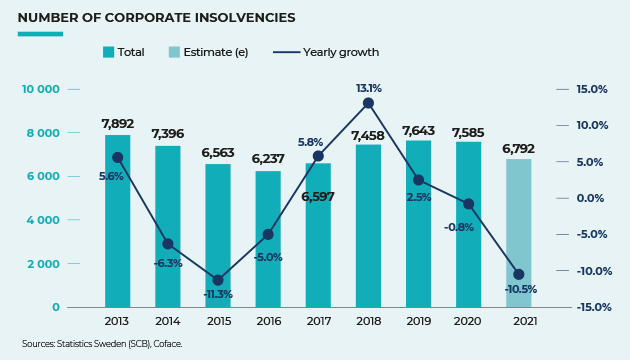

Sweden
Synthesis
major macro economic indicators
| 2020 | 2021 | 2022 (e) | 2023 (f) | |
|---|---|---|---|---|
| GDP growth (%) | -2.3 | 5.0 | 2.6 | -0.8 |
| Inflation (yearly average, %) | 0.5 | 2.2 | 8.4 | 8.3 |
| Budget balance (% GDP) | -2.8 | -0.1 | 0.2 | -0.2 |
| Current account balance (% GDP) | 5.9 | 5.4 | 3.3 | 3.3 |
| Public debt (% GDP) | 40.0 | 36.3 | 31.4 | 28.7 |
(e): Estimate (f): Forecast
STRENGTHS
- Very favorable business climate
- Very diversified economy, specialised in high-tech products (automotive, aviation, telecommunication, nuclear power)
- Solid public and external accounts, low debt
- High standard of living
- Positive demographical development due to immigration
WEAKNESSES
- Not a NATO member yet, membership formalities are under way
- Highly dependent on global demand (exports of goods and services = 46.3% of GDP in 2021)
- Pressures on the real estate market given high debt levels and sizeable overvaluation relative to incomes and rents
- Substantial household debt (203% of personal disposable income in 2021)
- Highly concentrated banking sector
Cocktail of external shocks to weigh on growth in 2023
After an episode of strong growth in the first half of 2022, driven by robust private consumption and investment, the Swedish economy is expected to slow over late winter 2022 period and into early spring of 2023 due to high inflation. The Russian invasion of Ukraine has only had a small direct impact as Sweden imported a mere 1% from Russia and exported barely 1.3% to it. Instead, the main impact of the Russia-Ukraine war has taken the shape of export blockades, supply chain issues and lower energy supplies, which have led to spikes in global prices, especially for energy and food. This pushed the average yearly inflation rate in Sweden to over 8.3% in 2022, i.e., its highest level since 1991. Price pressures are eroding household purchasing power and private spending is therefore expected to soften over the spring months. Additionally, weaker purchasing power is unlikely to be compensated by higher wages despite pay talks in March 2023. Moreover, consumer prices will increase further during 2023, but at a slower pace than in 2022, thereby prompting the Riksbank to hike its policy rate, but in smaller steps than in 2022 when it rose by 250 basis points to 2.5%. Sharply rising interest rates have also caused trouble for private homebuilders as most real estate mortgages in Sweden are granted with variable interest terms. Since the beginning of 2022, home prices have been decreasing as less people can afford them. In addition, shortages of labour and construction materials have pushed construction costs up noticeably in recent years. Construction activity should therefore stabilise or even decrease during 2023. Additionally, foreign trade will be slightly less positive. Goods exports should increase at a slower pace due to supply-chain issues and lower external demand. Despite robust state support measures such as fuel tax cuts, unemployment benefits and local government grants, private investment should slow in the first half of 2023. However, financing provided by the EU Recovery and Resilience Facility, which is expected to include disbursements of around 0.2% of GDP, will support climate-related investments.
Return to twin surpluses just out of reach
The country’s current account surplus will remain unchanged in 2023 as the trade in goods surplus will stabilise slightly thanks to a lower inflation rate for imports that will balance out a decrease in external demand. The trade in services switched to deficit in 2022 and is set to remain there as Sweden is a very expensive tourist destination for Western Europeans. The general government budget balance is likely to show a slight deficit as the government maintains its robust support measures to address high energy prices and bolster Sweden’s defence capabilities. However, public debt should decrease further and remain at a very low level.
A conservative government and NATO membership application
The last parliamentary election in September 2022 was a very close fight. The difference between the two major factions of the Swedish political system was tiny, with the former right-wing opposition party narrowly winning with 176 seats (out of 349 seats in the parliament). The former ruling Social Democratic Party (SAP) secured 107 seats (up 7 seats compared to the previous election in 2018) and became the largest party in the Riksdag. However, with the exception of the Green party (18 seats, up 2 seats), the other former coalition partners (Left and Centre parties) turn in a disappointing performance, losing a total of 11 seats. What is more, these 11 seats were won by the far-right anti-immigration Sweden Democrats (SD) party, which, with 73 seats, became the second-biggest party in Parliament and therefore the kingmaker. Third in the race was the liberal-conservative Moderate Party (70 seats, down 2 seats). In the past, all parties in Parliament refused to work directly with the Sweden Democrats, which would again have caused a political gridlock. After a fiery debate between lawmakers, Sweden’s parliament narrowly approved centre-right Moderate Party leader Ulf Kristersson as Prime Minister. The Kristersson cabinet (formed by Moderates, the Liberals and the Christian Democrats) is a minority government, which has 103 out of 349 seats. The SD is not a formal member of the coalition, but is backing it in Parliament in exchange for some influence over government policy. The new government’s coalition agreement includes proposals to cut taxes and cap welfare benefits, but is also heavy on law and order, and plans to crack down on criminal gangs. It aims to build more new nuclear power plants. Overall, the governing coalition is expected to remain in office until the next election, which is due to be held in 2026. Amid developments in the Russia-Ukraine war and despite having a long tradition of neutrality, the country signed the accession protocol to join NATO in July 2022. However, to gain entry, all existing member countries have to acquiesce. At the time of writing, Hungary and Turkey were the last two roadblocks to NATO membership, while the other 28 states had the treaty changes ratified in their national Parliaments. In response Russia has started to warn Sweden (as well as Finland, the other NATO candidate) that if NATO military contingents and military infrastructure were deployed, it would be obliged to respond in kind.
Last updated: April 2023
PAYMENT
Bills of exchange and promissory notes are neither widely used nor recommended as they must meet a number of formal requirements in order to be considered as legally valid.
Just as the rules for issuing cheques have become more flexible, the sanctions for issuers of uncovered cheques have been relaxed over the years. The use of cheques has subsequently become almost non-existent.
Conversely, use of the SWIFT electronic network by Swedish banks provides a secure, efficient, and cost-effective domestic and international fund-transfer service. Payments are dependent on the buyer’s good faith. Sellers are advised to ensure that their bank account details are correct if they wish to receive timely payment.
Direct debits represent about 10% of non-cash payments in Sweden and are quickly growing in popularity. There are two types of direct debit in Sweden: Autogiro Foretag (AGF) for B2B transactions and AutogiroPrivat (AGP) for B2C payments. They can both be used for single or recurring payments.
DEBT COLLECTION
AMICABLE PHASE
Amicable settlement aims to recover the debt without transferring the case into a trial procedure. The debtor is informed (either orally or via writing, with written correspondence being preferred) about the debt, the payment deadline, and the consequences of not paying the debt. If debtor agrees to pay the debt, both parties may settle on instalment payments through an official document that sets out the contractual terms of the agreement.
When there is no specific interest clause in the contract, the rate of interest applicable since 2002 is the six-monthly benchmark rate (referensräntan) of the Central Bank of Sweden (Sveriges Riksbank), plus eight percentage points.
Under the Swedish Interest Act (räntelag, 1975, last amended in 2013), interest on damages is awarded from the 30th day following the day on which the creditor addressed a written claim for damages to the defendant, if the plaintiff so requests. In any event, interest may be awarded from the date of service of the summons application.
LEGAL PROCEEDINGS
Fast-track proceedings
Where claims meet some basic requirements (e.g. payment is overdue, mediation was attempted), creditors can obtain an injunction to pay (Betalningsföreläggande) via summary proceedings through the Enforcement Service. The application has to be made in writing and clearly express the grounds of the claim. No further proof needs to be submitted.
This Enforcement Authority (Kronofog–demyndigheten) orders the debtor to respond within a period of ten days to two weeks. If the debtor fails to reply in time or acknowledge the debt, a verdict will be rendered on the merits of the original application.
While formal, this system offers a relatively straightforward and quick remedy in respect of undisputed claims, which has greatly freed up the courts. Creditors are not required to hire a lawyer but, in some circumstances, would be well advised to do so. On average, the process takes two months from application to decision. The decision is immediately enforceable.
Court proceedings
If the debtor contests the debt, the creditor has the decision of either turning to the District Court (the first instance, Tingsrätten) or to terminate the process.
Proceedings involve a preliminary hearing in which the judge attempts to help the parties reach a settlement after examining their case documents, evidence and arguments. It is up to the parties themselves to decide what evidence they wish to submit.
If the dispute remains unresolved, the proceedings continue with written submissions and oral arguments until the main hearing, where the emphasis is on counsels’ pleadings (defence and prosecution) and examination of witnesses’ testimonies.
In accordance with the principle of immediateness, the court bases its decision exclusively on the evidence presented at the trial. Barring exceptional circumstances, the judgement is customarily issued within two weeks thereafter.
As a general rule, the Code of Civil Procedure requires the losing party to bear all legal costs considered reasonable, as well as the attorney fees incurred by the winning party beyond a given threshold claim amount (about SEK 23,800, approximately EUR 2,390).
It takes up to twelve months (in exceptional cases more) to obtain a writ of execution in first instance, bearing in mind that there is a widespread tendency in Sweden to appeal against judgements.
ENFORCEMENT OF A LEGAL DECISION
As soon as a domestic judgment becomes final, it is enforceable. If the debtor does not comply, the creditor can request the court’s enforcement authority to seize and sell the debtor’s assets.
For awards rendered in an EU member-state, special enforcement conditions are provided. When the claim is undisputed, the creditor may apply to the European Enforcement Order, or when the claim does not exceed €2,000, the creditor may start a European Small Claim Procedure. For awards issued in non-EU countries, the Svea Hovrät Court of Appeal must recognize an award in order to enforce it, provided that a recognition and enforcement agreement has been signed between the non-EU country and Sweden.
INSOLVENCY PROCEEDINGS
Out-of court proceedings
Swedish law does not formally regulate out-of court arrangements. Nevertheless, creditors and debtors can enter into voluntary negotiations in order to negotiate the debt and reach an agreement.
Restructuring
The aim of restructuring is to find a financial solution for an insolvent company that is deemed to have sustainable long-term business prospects. It can apply for a restructuring with the local court. If approved, the court will appoint a rekonstruktör to manage the restructuring. The latter will investigate the financial situation of the company, before establishing and implementing a restructuring plan under which up to 75% of the debt may be written off.
Bankruptcy
Bankruptcy proceedings are initiated as a consequence of a company becoming permanently insolvent. They aim to wind down an insolvent company by selling its assets and distributing any income to creditors. Either the debtor or the creditor can file a petition before the local court. After the court has declared a company bankrupt, it appoints an administrator that independently takes control over the company’s assets with the main task of realising such assets and repaying the debts of the bankruptcy estate in accordance with the creditors’ statutory ranking.




